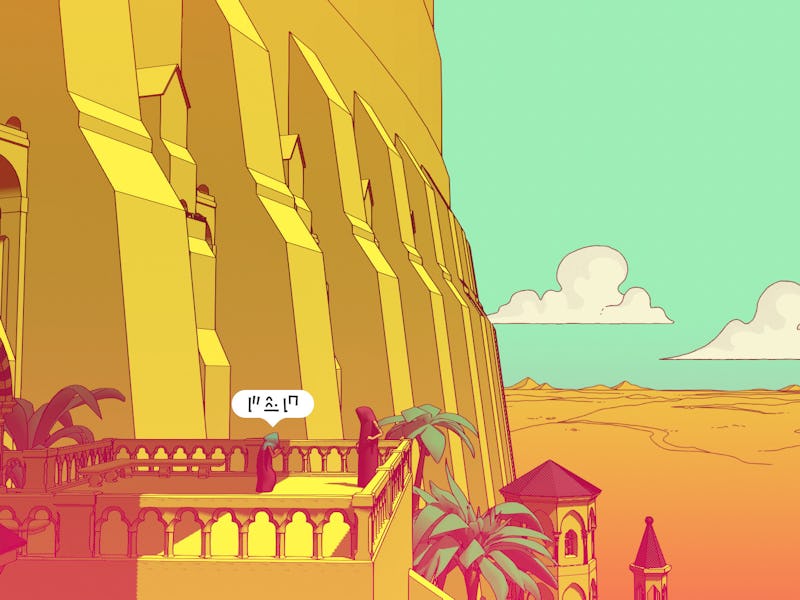
Upon entering a new room filled with moats, I am confronted by a mysterious robed figure across the water. They raise their hand to me in greeting, an unreadable symbol accompanies this. Hello, they are saying hello to me I quickly realize. I open my notebook and jot down a working translation of this new symbol. Piece by piece, I begin to understand the mysterious figure.
This fascinating exercise in working through the language barrier occurs in the first few minutes of Chants of Sennaar, which I previewed during Tribeca Games 2023. Out of the seven titles on the festival’s official selection, Chants of Sennaar’s truly inventive translation-based gameplay blew me away — and it’s become one of my most anticipated games of the fall.
As a game that revolves around the act of translation, it is no surprise that French developer Rundisc’s main inspiration for Chants of Sennaar is the biblical tale of the Tower of Babel. As the story goes, the high-reaching structure invoked God’s rage and led to humanity being scattered across the Earth and different languages being formed so people could not communicate with each other. This is the world in which Chants of Sennaar takes place, on different levels of a tower inhabited by different communities. Each group has its own language, and you know none of them.
Early on, Chants of Sennaar draws upon intuitive puzzle design to teach language comprehension. A closed door halted my progress, next to it was a lever. Next to that lever was a plaque with two strings of symbols stacked on top of each other horizontally and separated by a line. For ease of understanding, let's say the top string of symbols was AC, while the bottom string was BC. Flipping the lever to the down position opened the door. When reading, these symbols are automatically jotted down in your in-game journal. You’ll then have to create translations of each symbol you encounter.
Understanding that the plaque was instructions for the door, I gathered that since C was in both strings of symbols then that had to be the symbol for door. The top string correlated to having the lever in the upright position, which closed the door — so A translates to close. Similarly, B translates to open. Sketches of the door and lever appear on another page of the notebook and I put my working translations for each symbol on the picture. The symbols lock into place and the game confirms my translations.
Chants of Sennaar’s translation mechanic is an innovative piece of game design that requires players to think for themselves.
Solving this introductory puzzle left me elated with joy. That feeling would continue through the rest of my roughly 45-minute demo. The puzzles begin relatively simply but quickly grow in complexity. Halfway through the demo, I cut to a point further into the game where I was working with three different languages, translating symbols in each one while also finding correlating symbols between them all. The scope of Chants of Sennaar is truly awe-inspiring and itches the scratch I have not been able to fully satisfy since playing 2018’s Return of the Obra Dinn.
Like Obra Dinn, Chants of Sennaar’s core gameplay loop revolves around complex puzzles that require the player to make actual logical inferences about the way the world works. Obra Dinn relied on constant observation and making leaps in logic to solve murders, while Chants of Sennaar uses multiple languages to encourage the player’s mind to understand the intricacies of human communication and how we use spoken and written language.
I left my preview desperate to play more. I only hope this game is not struck down by some higher power before its release on September 5. (It’s a real worry for something just as ambitious as the tower that inspired it.)